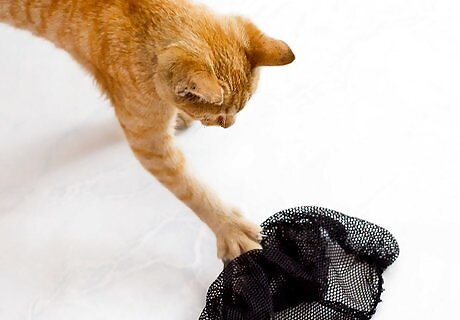
views

Safety first. Don't compromise your own safety. This includes not going into any area that may be dangerous, such as a construction site, an abandoned mining area or a dilapidated building. Moreover, don't put yourself in a precarious position to try to reach the cat. Make sure you are on a solid surface that won't fall out from under you or cause you to slip or fall. Finally, do not attempt to touch a stray cat unless you are absolutely certain it won't attempt to bite or scratch you. Bring hand sanitizer to clean your hands immediately after touching or carrying a stray cat.

Start by visiting the cat. Find where it hangs out. Use that place as a neutral meeting ground to allow the cat to become familiar with you. Over time, the cat will become comfortable the more you visit. At first, don't try to touch or crowd it in any way.

Stay calm. When you first approach the stray cat, it may hide. Don't try to chase it out of its hiding place. Instead, just sit there and pretend not to pay attention to it. Do something else (bring a book to read or your favorite app to play with). Wait a while. If the cat is still hiding, leave and come back the next day. The cat may come over to you right away. If it does, look for signs of fleas or sickness.

Make tentative moves toward the cat to see how it reacts. Once the cat is used to you and is willing to come closer, test how it feels about you. If you have determined that the cat is healthy, extend your hand without actually touching it. If the cat tries to scratch you, don't stroke or pet it. If it does not show aggression, then just let it sniff you. Once it seems okay with you, you can then consider stroking it. First let it get used to you, which includes letting it get used to your odor. This is important so don't push things too quickly. If the cat starts to purr or rub itself against you, you've made a friend. Rubbing means it's transferring its scent to you and making you part of its family. So, don't worry––this won't do you any harm----in fact, you're making progress. Allow plenty of getting-to-know-each-other time before petting the cat. It may take a few attempts before the cat will let you. Be on your guard if the cat attempts to scratch you or lets out a yowl. It is giving you a serious warning. It may feel you're rushing it, so don't. In some cases, the cat may never stop trying to scratch, in which case, you probably won't be able to bond with it effectively. But can still care for the cat without direct handling.

Feed the cat. Bring dry or wet cat food and a water bowl. Come every day, preferably twice a day to feed it. Some cats love company when they eat; this may be a suitable time to stroke it, or to at least sit beside it while it is eating or drinking. On the other hand, some cats are really bothered by being touched when they eat, so gauge the cat's reaction carefully. Hand feed the cat some treats. This will increase bonding and the stray cat will enjoy it.

Play with the cat. Use basic cat toys, such as scrunched up pieces of paper, a stick with something dangling from the end, a long and large leaf or twig, etc.

Bring a cat brush along. Cats love to be brushed although it can take time before a stray cat will trust you to do this. When it lets you, take it easy and brush gently and carefully.

Eventually, you may decide to bring the cat home. If you do, this should be done with care. Ideally, you should take the cat to a veterinary clinic first, especially if you own other cats or pets. The stray may be carrying an infection or disease that you haven't noticed. Take along a suitable cat carrier. It must be strong, sturdy and safe for the cat. Borrow one if you don't already own one. Book an appointment with the vet. Explain that you're bringing a stray in and that you intend to keep the stray after it has been checked, had its microchip read (if there is one) and vaccinated. The microchip (if present) will give you the opportunity to track down a previous owner. Take the cat home. If the cat gets the all clear, take it home and begin its settling in time.




















Comments
0 comment